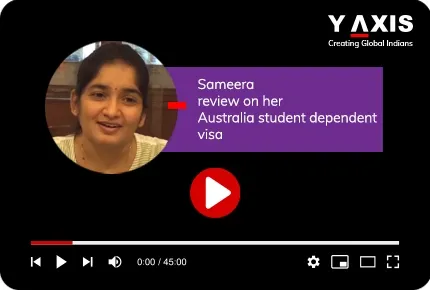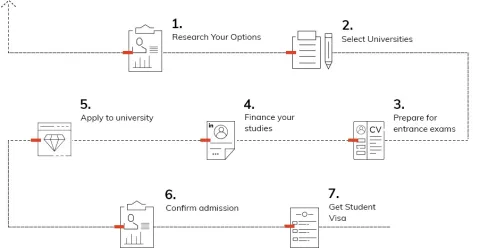Australia is one of the best places for higher studies, and the country attracts thousands of students each year from all over the world. Australian universities provide world-class education, are recognized globally, and research is considered one of the key components of any graduate course. The universities support students who come up with the best research ideas, and scholarships are provided according to the research work. Here are also some other reasons to study in Australia:
- Affordable Education
- Innovative and Abundant Research Opportunities
- Immigration Possibilities
- Exciting Campus Lifestyle
- Healthy and Safe Communities
- Work and internship opportunities for international students while they study
Educational Qualification
- The minimum eligibility criteria to graduate is you have to score at least 60% from a UGC or AICTE recognized university.
Year Back
- The graduation degree has to be completed within the stipulated time with no gap year.
- Example: B.Com is a 3-year degree. The client should have completed it within 3 years and not more.
- Example: Engineering is a 4-year degree. The client should have completed within 4 years and not more.
Backlogs
-
The client should not have more than 10 backlogs in his/her graduation period.
Average Fees
$12,000 to $25,000 per year
$24,000 to $35,000 per year
$7,000 to $10,000 per year
February
July
November
Student Applicant:
-
Students must be over 18 years of age.
-
International students in Australian universities can work on-campus or off-campus for up to 20 hours during university semesters and full-time during breaks, such as the winter or summer holidays, without needing a work permit.
-
International students studying in a program that requires work experience, such as through a co-op or internship program.
Spouse:
- In general, spouses are given the same rights as students already in Australia. Therefore, if a student with an Australian student visa has the right to work, the spouse who comes to join him or her will also have that right.
Description
Australian National University
University of Melbourne
University of Sydney
University of New South Wales
University of Queensland
Monash University
University of Western Australia
University of Adelaide
University of Technology Sydney
University of Wollongong
RMIT University
University of Newcastle
Curtin University
Macquarie University
Queensland University of Technology
Deakin University
University of Tasmania
Swinburne University of Technology
Griffith University
La Trobe University
University of South Australia
Flinders University
James Cook University
Bond University
Western Sydney University
University of Canberra
Murdoch University






Australia and Canada are becoming top choices for Indian students, offering quality education, diverse opportunities, and a bright future post-graduation.
Australia and Canada Emerge as Leading Education Destinations for Indian Students
Recent Indian students abroad news reveals a remarkable milestone: India has become the second-largest source of international students globally, with 1.3 million students pursuing education overseas. Particularly significant is the growing presence of Indian students in Australia and Canada, where the numbers tell a compelling story.
In fact, Indian students accounted for more than 40% of all study permit holders in Canada in 2023, reaching 427,085 students. Similarly, Australia welcomed 163,450 Indian students in 2023/24, establishing itself as another preferred destination.
However, recent policy changes have led to interesting shifts, with Canada experiencing a 46% drop in international applications in 2024, while emerging destinations like Germany have seen a 68% increase in Indian student enrollment from 2022 to 2024.
Australia Opens Doors for Indian Students Seeking Quality Education
Australia's education system has become increasingly attractive to Indian students, with over 122,391 Indian students enrolled in Australian institutions from January to September 2023, making India the second-largest source of international students in the country. Recently, a significant milestone was reached when India overtook China in Australian student visa grants for 2025, with more than 5,000 student visas already issued to Indians in the first two months of the year.
The surge in popularity stems from Australia's world-class education offerings, with nine Australian universities ranking in the top 100 globally in the QS World University Rankings. These institutions have collectively contributed AUD 47.8 billion to the Australian economy, underscoring the significance of international education.
Indian students are particularly drawn to certain fields of study. Business analytics, MBA programs, and computer science rank among the most popular choices, alongside data science, cyber security, artificial intelligence, and healthcare programs. Additionally, courses in accounting, finance, hospitality management, and engineering continue to attract substantial interest.
The Australian government has implemented several measures to welcome Indian talent. These include extended post-study work rights of up to six years depending on degree level and location, streamlined visa pathways, and generous scholarship opportunities. Currently, student visa holders can work up to 48 hours per fortnight during their studies.
For prospective students, the financial investment involves tuition fees ranging from AUD 20,000 to AUD 40,000 annually, plus approximately AUD 5,000 for living expenses, depending on location. Furthermore, all international students must maintain Overseas Student Health Cover (OSHC) throughout their stay.
Beyond academics, Australia offers a safe, inclusive environment with seven cities ranking among the world's top 100 student cities for 2024. Consequently, the number of Indian students choosing Australia is expected to surpass 101,552 by 2025, reinforcing Australia's position as a premier education destination.
Canada Transforms Its Education Landscape to Welcome Indian Talent
Canada's education policies have undergone significant transformations as the country recalibrates its approach toward international students, especially those from India. In 2024, Canada issued 518,125 study permits, with Indian students receiving 189,070 permits—the largest contingent, followed by Chinese students with 56,550 permits.
Immigration Minister Marc Miller has recently urged Canadian universities and colleges to diversify their international student recruitment beyond India. Although Indian students will continue to play an important role in Canada's education system, institutions are being encouraged to expand their outreach to countries in Africa, Southeast Asia, and Latin America.
The rapid growth of Canada's international student population has created both opportunities and challenges. On one hand, it has generated substantial financial benefits for educational institutions. On the other hand, it has contributed to housing shortages, labor exploitation concerns, and questions about educational quality at some private colleges.
Despite these challenges, Canada remains a highly desirable destination for Indian students. The country ranks fourth globally for education quality and third out of 85 countries for quality of life. Moreover, Canada offers valuable work opportunities through its Post-Graduation Work Permit (PGWP) program, allowing graduates to gain professional experience for up to three years.
Nevertheless, recent policy changes have affected application numbers. In January 2024, the Canadian government announced caps on study permits for undergraduate students, resulting in a 20% decrease in permits issued compared to the previous year. Notably, approval rates for Indian students improved to 90%, up from 63% previously.
For graduate students, Canada will implement study permit caps beginning with the 2025/26 academic year. Graduate study permits decreased by 19% overall in 2023/24, with Indian permits falling by 35%.
Financial requirements have also changed, with cost-of-living requirements doubling from USD 10,000 to USD 20,635. Additionally, eligibility for the PGWP program has narrowed, with only graduates from public institutions in specific labor-shortage fields now qualifying.
Accordingly, many Indian students are reassessing their options, though Canada's quality education, inclusive society, and pathways to permanent residency still make it an attractive destination for those who plan strategically.
Indian Students Share Their Success Stories from Down Under to the Great North
Beyond statistics and policies lies the human story of Indian students navigating life in Australia and Canada. Many students report contrasting experiences between the two nations, with several factors shaping their educational journeys.
The reality for Indian students in Australia often includes unexpected challenges. A third-year IT student in Sydney recently shared that despite anticipating quality education and employment opportunities, they instead encountered high housing costs, mediocre educational experiences, and poor-quality jobs that barely covered living expenses. "I feel tolerated, not included," the student noted, highlighting difficulties in forming genuine friendships beyond superficial interactions with locals.
Job market barriers present significant hurdles in Australia. Many positions require permanent residency or local work experience, pushing international graduates toward retail or delivery jobs rather than career-relevant opportunities. This misalignment between immigration policies and employment realities leaves many questioning their educational investment.
Conversely, Canada continues to attract Indian students through more welcoming immigration laws, affordable living costs, and stronger pathways to permanent residency. The country's inclusive and diverse society particularly appeals to Indian students seeking both quality education and post-graduation opportunities.
Cultural adjustment remains challenging in both countries. From unfamiliar customs to different food and social norms, the initial transition can be overwhelming. Homesickness affects many students' emotional well-being and academic performance. To overcome these hurdles, students typically:
- Participate in cultural activities and campus organizations
- Connect with fellow Indian students while building diverse friendships
- Maintain strong ties with family and friends back home
Indeed, studying overseas offers transformative opportunities alongside significant challenges. While some students struggle with isolation and employment barriers, others successfully integrate into their host countries, finding that international qualifications open doors globally and provide valuable cross-cultural competencies.
Conclusion
Overall, Australia and Canada stand as compelling alternatives for Indian students seeking quality international education. Australian universities offer world-class programs, especially in technology and business fields, while maintaining strong global rankings. Their extended post-study work rights and welcoming environment make the country an attractive destination for career-focused students.
Canada's education landscape continues to evolve through policy adjustments and diversification efforts. Though recent changes present new challenges, the country's high education standards and quality of life remain significant draws for Indian students. Additionally, improved visa approval rates and structured pathways to permanent residency demonstrate Canada's commitment to supporting international talent.
Student experiences highlight both opportunities and obstacles in these countries. Housing costs, cultural adjustment, and employment barriers pose real challenges. Therefore, careful planning and research become essential for success abroad. Undoubtedly, those who navigate these challenges often emerge with valuable cross-cultural competencies and global career prospects.
These shifting dynamics signal broader changes in global education patterns. As Indian students become increasingly mobile and selective, Australia and Canada must balance their educational offerings with sustainable growth policies. Their success in maintaining this balance will shape future opportunities for countless aspiring Indian students seeking international education.
